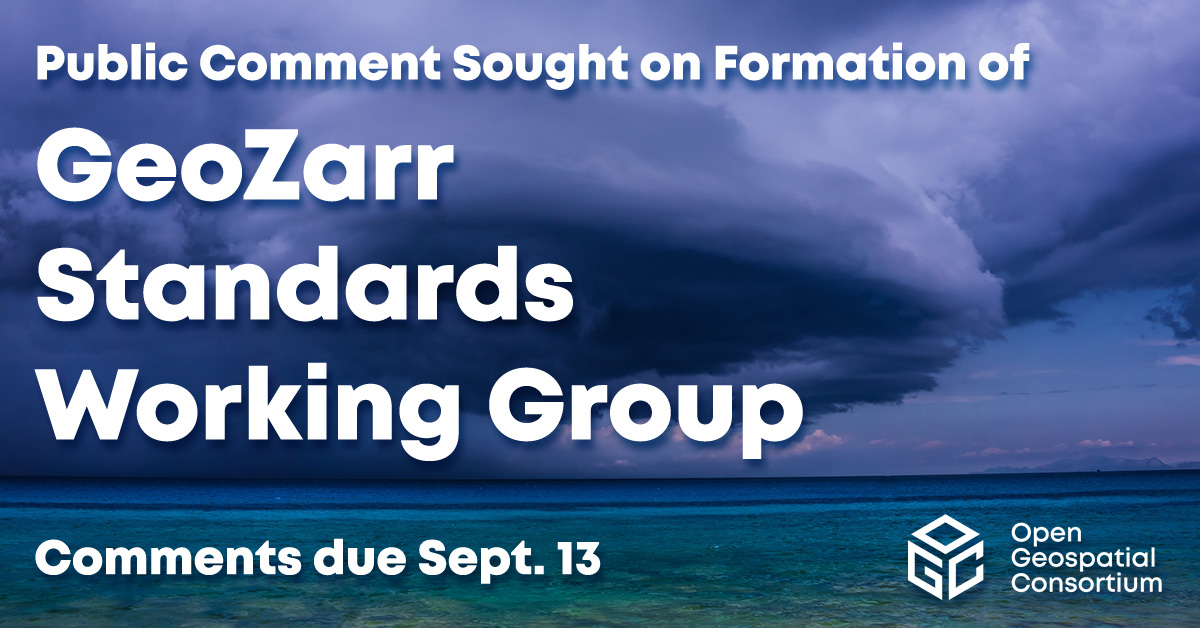Request Closed: August 23, 2023 12:00 am — September 13, 2023 11:59 pm (AoE)
The Open Geospatial Consortium (OGC) is looking to form a GeoZarr Standards Working Group (SWG) that will develop a Zarr encoding for geospatial gridded data in the form of Zarr conventions. Public comment is requested on the SWG’s charter. Comments are due by September 13, 2023.
In the geospatial world, new cloud-native data formats are emerging. Zarr is a generic data format for n-dimensional arrays that enables access to data in compressed chunks of the original array. Zarr has become increasingly popular to use for geospatial purposes. Zarr facilitates portability and interoperability on both object stores and hard disks.
In June 2022, OGC endorsed Zarr V2.0 as an OGC Community Standard. The purpose of the GeoZarr SWG is to have an explicitly geospatial Zarr Standard (GeoZarr) adopted by OGC that establishes flexible and inclusive conventions for the Zarr cloud-native format that meet the diverse requirements of the geospatial domain. These conventions aim to provide a clear and standardized framework for organizing and describing data that ensures unambiguous representation.
The objectives of GeoZarr conventions include:
- Compatibility: Ensuring easy compatibility with popular mapping and data analysis tools such as GDAL, Xarray, ArcGIS, QGIS, and other visualization tools, enabling seamless integration into existing workflows.
- Dimensions: Supporting multi-dimensional data, such as hyperspectral and altitude information, to address diverse geospatial data requirements.
- Data Discovery: Providing metadata for discovering, accessing, and retrieving the data, including composite products made of multiple data arrays.
- Mixing Data: Facilitating the combination of different types of geospatial data, including satellite images, elevation maps, and weather models, to create comprehensive and informative datasets.
- Flexibility: Allowing scientists and researchers to work with diverse data types and projections in their preferred software and programming languages, promoting flexibility and adaptability in geospatial data processing and analysis.
In addition to the encoding of geospatial data and metadata, the GeoZarr Standard will provide a multi-dimensional alternative to the two-dimensional Cloud-Optimized GeoTiff format (COG – adopted by OGC in May 2023), which has lately gained popularity due to its serverless capabilities. These capabilities will allow for inherent support of traditionally server-based functions, such as visualization (similar to OGC API – Maps), data subset access (analogous to OGC API – Coverages), and symbology (equivalent to OGC API – Styles). These aspects are planned to be incorporated as optional profiles (e.g. conformance classes).
The draft GeoZarr Standards Working Group Charter (23-046) (.HTML) is available for review and comment on the OGC Portal. Comments are due by September 13, 2023, and should be submitted via the method below.
To Comment:
Comments can be submitted to a dedicated email reflector for a period ending on the “Close request date” listed above. Comments received will be consolidated and reviewed by OGC members for incorporation into the document. Please submit your comments via this email address, using this Comments Template for the message body.
Subscribe to Comments:
You may wish to subscribe to the distribution list to receive comments as they are submitted. Subscribing to the list will also allow you to view comments already received, which can be found in the List Archives.
